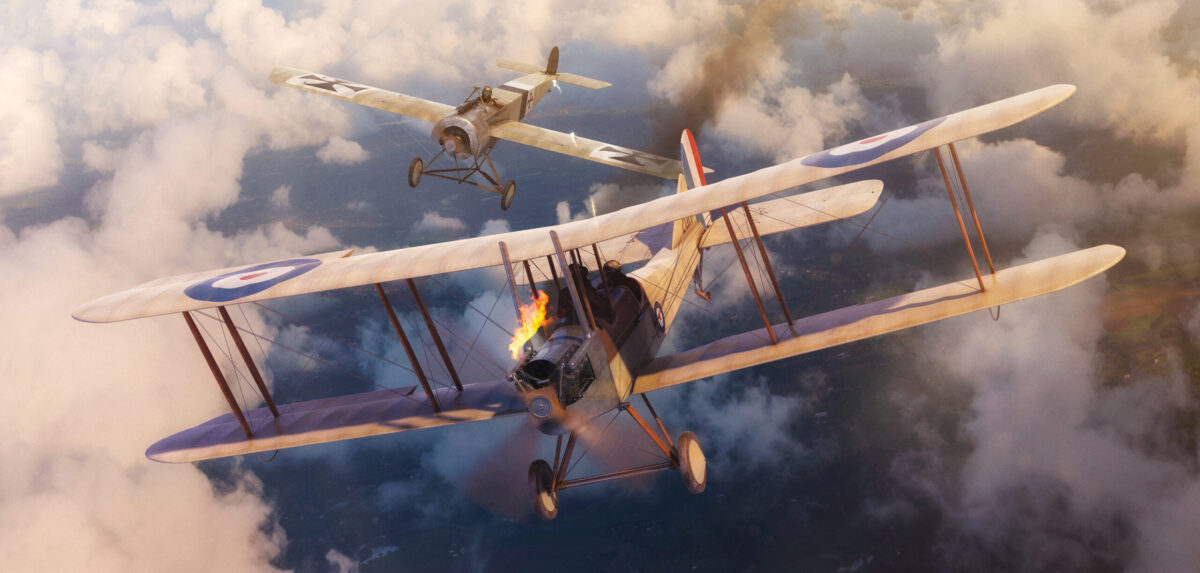For more than a century the Royal Aircraft Factory’s B.E.2c has been denigrated as one of the worst aircraft ever made. Even during World War I, when it was on active service with the British Royal Flying Corps (RFC), the B.E.2c was condemned as a death trap that lacked the speed and maneuverability to evade attack as well as any effective armament with which to defend itself. Although there was some justification for those assessments, critics overlook the fact that the aircraft originated before WWI began, and before those criteria were even considered. In fact, the principal considerations in the B.E.2c’s design were stability, ease of handling and safety, not speed, agility or defensive capability.
In fairness, the B.E.2c’s negative reputation may be an exaggeration. Much of that stems from the fact that the airplane remained in production and operational long after it clearly had become obsolete. In addition, the Royal Aircraft Factory in general, and the B.E.2c in particular, received negative publicity generated by a segment of the British aircraft industry, particularly by Noel Pemberton-Billing, a vocal member of Parliament and self-proclaimed aviation expert.
The Royal Aircraft Factory (RAF, not to be confused with the Royal Air Force, which wasn’t formed until April 1918) was established at Farnborough in 1906 when the Army Balloon Factory branched into development of heavier-than-air flying machines. Although assigned to create aircraft for the British Army’s newly established Royal Flying Corps, from the outset the institution was more of an experimental and developmental establishment than a production facility. Indeed, despite accusations from the aircraft industry that the British government was unfairly competing against private enterprise, the vast majority of RAF designs, including the B.E.2c, actually were manufactured by private companies rather than by the RAF itself.
The story of the B.E.2c begins with the B.E.1, the airplane from which it derived. The B.E.1 project was supposed to have been simply the repair of a damaged airplane; instead, in 1911 designer Geoffrey de Havilland created an entirely new one. His B.E.1 was a two-seat general purpose tractor biplane, with the “B.E.” signifying “Blériot Experimental.” (To the RAF “B.E.” meant any tractor-type airplane, while pusher airplanes received the designation “F.E.” for “Farman Experimental.”) All that remained of the airplane de Havilland was supposed to repair was the engine, a 60-hp liquid-cooled Wolseley V-8. In December 1911 de Havilland piloted the B.E.1’s first flight himself and he delivered it to the RFC early in 1912.
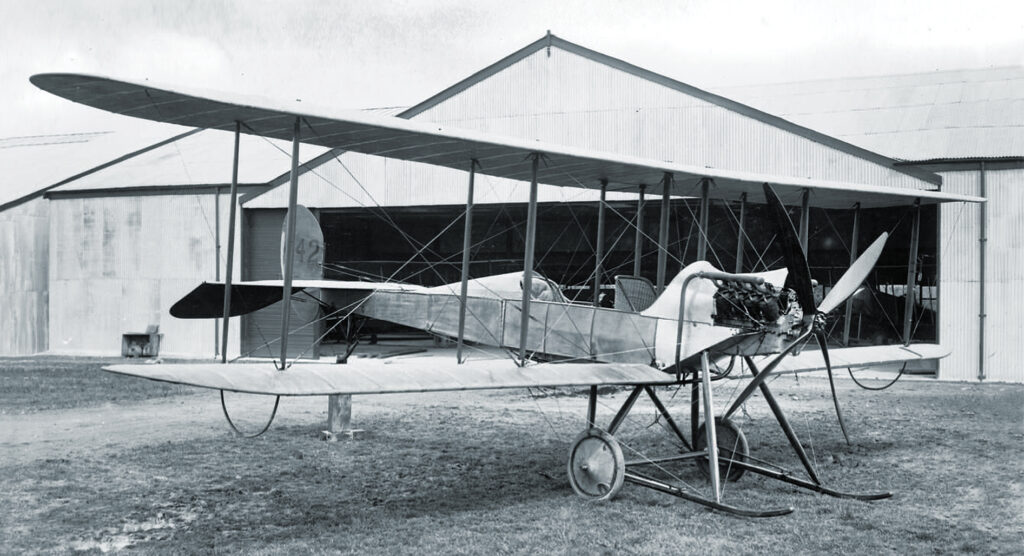
The B.E.1 was a two-seat airplane with unstaggered biplane wings and tail surfaces consisting of a fixed airfoil-section horizontal stabilizer ahead of the elevators and a vertical rudder without a fixed vertical stabilizer. The observer sat in front of the pilot and occupied the center of gravity, enabling the aircraft to be flown without any alteration in trim if the observer’s seat was unoccupied. The airframe was wood, with the top and bottom of the fuselage covered with plywood for additional strength. Despite the early date of its design, the B.E.1 included all the characteristics one would currently recognize in an airplane save for the fact that, rather than ailerons, it employed wing warping for lateral control. On March 14, 1912, the B.E.1 became one of the very first aircraft to receive an official Certificate of Airworthiness.
In February 1912 the B.E.1 was succeeded by the B.E.2, which was almost identical save for the substitution of a 60-hp air-cooled Renault V-8 engine for the B.E.1’s less-than-satisfactory Wolseley. It also became the first standard type of aircraft the RFC adopted for use. In March 1912, less than a month after the B.E.2 entered service, the RAF used it to flight test a newly developed radio transmitter.
Only two B.E.2s were constructed before it was succeeded by the incrementally improved B.E.2a, a total of about 80 of which were manufactured, mostly by Vickers and Bristol. The total number of B.E.2bs manufactured is not certain, however, because many were apparently completed as the later and substantially improved B.E.2c version.
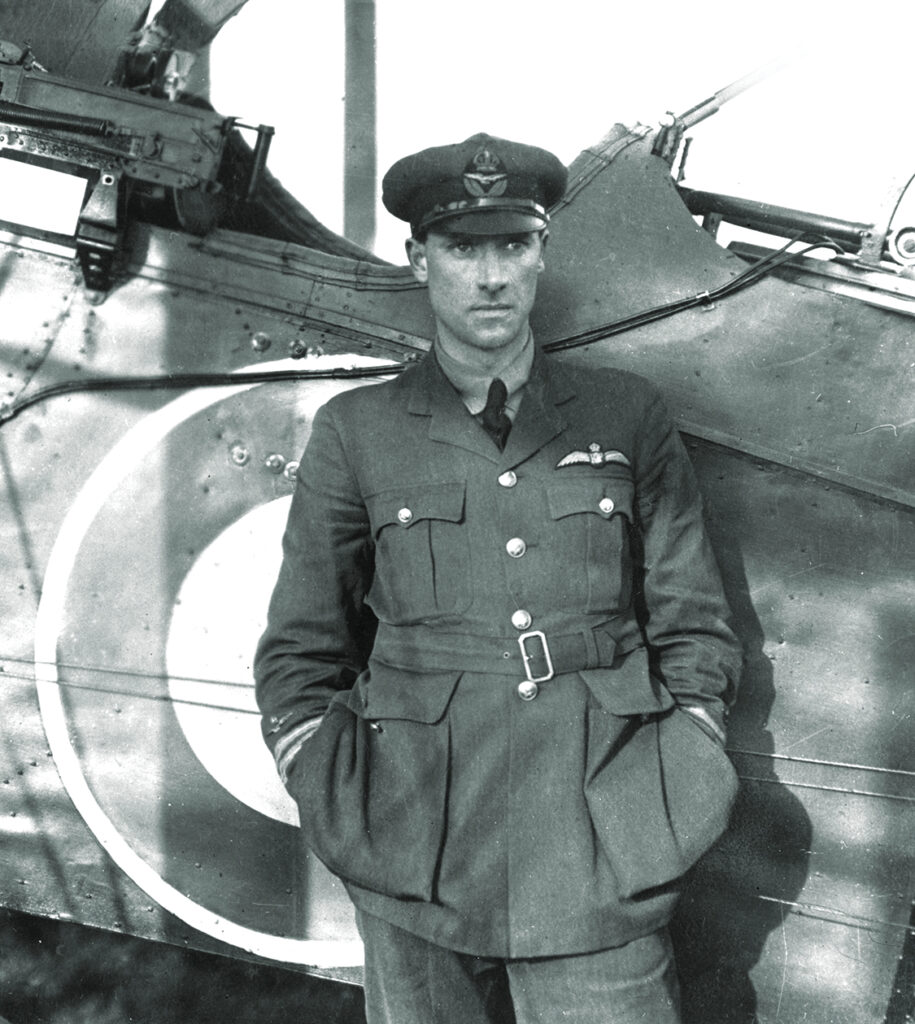
Once the RFC adopted the B.E.2 series for mass-production, the airplane became the subject of a series of experiments conducted by another brilliant young RAF designer and test pilot, Edward Teshmaker Busk. Educated at Eton and Cambridge, Busk became interested in perfecting aircraft stability. At the time, the British Army considered stability of vital importance—more than speed or maneuverability—because it wanted well-behaved reconnaissance airplanes in which the pilot could take his hands off the controls while making notes of enemy positions, taking photographs or even operating a radio transmitter. Positive stability was also important because early airplane pilots lacked blind flying instruments and could easily become disoriented in clouds and fall into a spin, something only an experienced pilot could survive.
Busk was both a theoretical and empirical engineer and he tested many ideas, including increasing dihedral, adding stabilizing fins to various parts of the airframe and even installing interplane struts incorporating additional side area. Although he test-flew many of his alterations himself, he also made use of a huge whirling arm, like an enormous centrifuge, to which he attached entire airframes in place of a wind tunnel.
As a result of his research, Busk redesigned the aircraft into the B.E.2c. While resembling earlier versions, this was almost an entirely new design. Not only did Busk add a large fixed vertical stabilizing tail fin, but he replaced the horizontal stabilizer with an entirely new design without the earlier version’s lifting airfoil section. He also revised the mainplanes with a new airfoil shape, new planform, positive stagger and added dihedral. Most noticeably, Busk replaced the old wing warping system with ailerons on all four wings, a change that strengthened the wing structure because the wings no longer needed to be flexible.
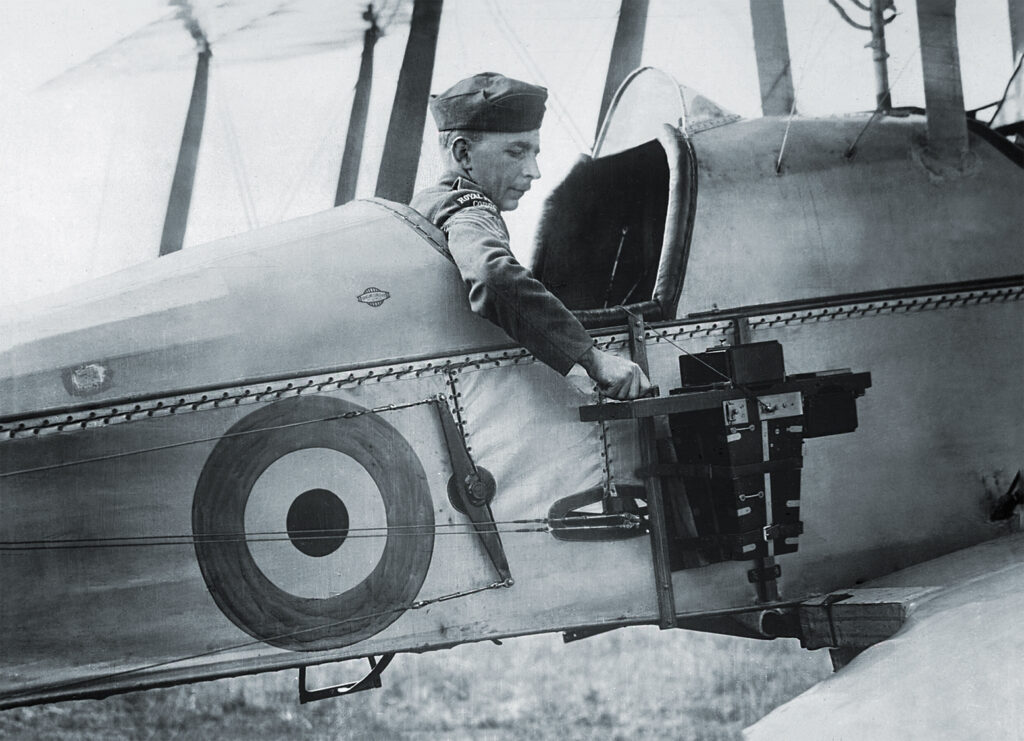
Powered either by a 70-hp Renault V-8 or a 90-hp RAF1a, both air-cooled V-8 engines, the B.E.2c could achieve a maximum speed of 72 mph, a ceiling of 10,000 feet and had an endurance of 3½ hours. From the first flight on May 30, 1914, pilots appreciated the B.E.2c’s docile qualities. On June 9, Major William Sefton Brancker flew his B.E.2c for 40 miles without ever having to touch the controls until he reached his destination and began to descend for a landing. Immediately popular with service pilots, the B.E.2c quickly superseded earlier versions of the aircraft on the production lines and was manufactured by no less than 20 aircraft companies. While initially intended for reconnaissance and observation, the aircraft later came to serve as bombers, trainers and even as fighters.
Edward Busk did not live long enough to enjoy his success. On November 5, 1914, he died when a B.E.2c he was test-flying caught fire in midair and crashed. Although it has never been confirmed, the fire may have been caused by the premature detonation of a new type of incendiary bomb developed by the RAF. Whatever the cause, Britain lost one of its most brilliant and promising engineers and test pilots at the age of 28.
The various B.E.2s may not have been the most warlike of airplanes, but no one could accuse the pilots who flew it of lacking aggressiveness. B.E.2 variants equipped the first RFC squadrons deployed to support the British Expeditionary Force in France. On August 13, 1914, B.E.2a No. 347, flown by Lieutenant Hubert D. Harvey-Kelly, became the first British warplane to fly across the English Channel. Twelve days later Harvey-Kelly and his observer, W.H.C. Mansfield, flew the same B.E.2a to score the first British air-to-air victory—after a fashion—when they attacked a Rumpler Taube with small arms they had brought with them. Forcing the startled Germans to the ground and driving them into the nearby woods for cover, Harvey-Kelly landed and, after collecting souvenirs from the Taube, set it on fire and took off again.
On April 26, 1915, 2nd Lt. William B. Rhodes-Moorhouse flew his B.E.2b into Belgium to drop a 100-pound bomb on the Kortrijk railroad junction. Wounded by ground fire, he managed to return to base and report the success of his mission before going to the hospital, where he died the next day. Rhodes-Moorhouse became the first pilot to receive the Victoria Cross.
After German U-boats began menacing British coastal shipping, the Royal Navy retaliated by ordering a fleet of anti-submarine patrol blimps. Rather than design a control car for the new airships, the Navy simply suspended B.E.2c fuselages beneath the envelopes. The Navy produced 27 “Submarine Scout” airships this way.
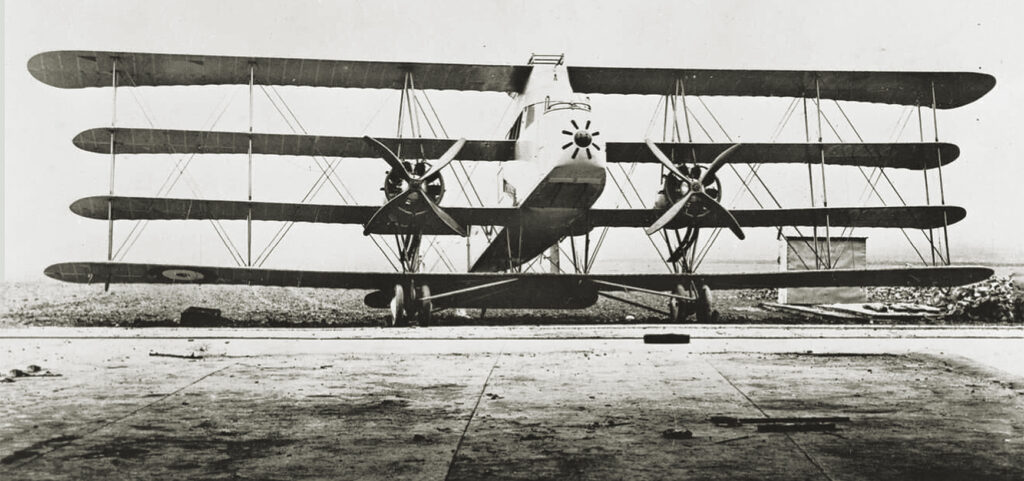
When German Zeppelin airships initiated night bombing raids on British cities, the B.E.2c took on a new role as a night interceptor. Although lacking the performance of single-seat scouts, the B.E.2c’s positive stability made it the safest choice for the role of a night fighter in the absence of night-flying instruments. B.E.2cs received credit for shooting down seven Zeppelins. After the first such instance, on the night of September 2-3, 1916, B.E.2c pilot Lieutenant William Leefe Robinson received the Victoria Cross.
During the first year of the war, few airplanes flew over the front, and they rarely encountered each other in the air. When they did, more often than not they lacked any effective armament with which to attack each other. However, the notorious “Fokker Scourge” against Allied aircraft began as early as July 1915 when the Germans introduced the Fokker Eindecker (monoplane), the first single-seat fighter to be effectively armed with a synchronized forward-firing machine gun. They produced only 416 of them, however, and never had many over the front lines. Moreover, the Eindeckers left a good deal to be desired as fighter planes. Since they relied on wing warping for lateral control, they were not very maneuverable and their wings were relatively thin and fragile. Furthermore, the limited power of available engines and the weight of the machine gun and ammunition meant that they could achieve a maximum speed of only 87 mph. Initially the Eindeckers were not deployed in specialized fighter squadrons but issued piecemeal, a few at a time, to mixed Feldflieger Abteilungen (Field Flying Companies), which operated several different aircraft types suited to perform a variety of aerial missions. As a result, the success of the Eindeckers during 1915 and early 1916 depended on luck and the aerial tactics developed by individual pilots. Even Oswald Boelcke, the most successful German fighter pilot of the first half of WWI, shot down only six Allied aircraft throughout 1915.
Nevertheless, the introduction of armed enemy aircraft highlighted the slow and stable B.E.2c’s vulnerability, transforming its positive qualities into liabilities. Although the British made attempts to install defensive machine guns on the B.E.2c, the observer/gunner’s position in the forward cockpit meant his field of fire was obstructed by the pilot, propeller, wings, struts and bracing wires. The RAF addressed the problem late in 1915 with the R.E.8, a two-seat reconnaissance plane with the observer seated more effectively in the rear with a machine gun. Due to the nature of the British War Office’s procurement system, however, many aircraft manufacturers could not shift production to the R.E.8 until they had fulfilled their B.E.2c contracts. The R.E.8 did not reach squadrons until November 1916, so the B.E.2c had to soldier on far longer than it should have done. By the time the R.E.8 appeared it, too, was becoming outdated, generating even more criticism of the RAF.
Much of that criticism came from Noel Pemberton-Billing. Born Noel Billing in 1881, he adopted the “Pemberton” during a brief stint as an actor. After fighting in the Boer War, he returned to England and became interested in aviation, getting his pilot’s license and launching an aviation company, Pemberton-Billing Ltd., which later became the foundation of the Supermarine company of Spitfire fame after Pemberton-Billing sold his interests. Pemberton-Billing won election to Parliament in 1916 and turned his attention and skills at invective to attack Britain’s aviation establishment. “The Government and its advisors, expert and otherwise, never believed in the reality of the air menace,” he wrote in his 1916 book Air War: How to Wage It. “They sneered at the Zeppelin, they laughed at the aeroplane. Who laughs today? Who pays the price for the work that was not done?” Pemberton-Billing even built a huge and grotesque twin-engine, multi-seat quadraplane, the Supermarine Nighthawk, for intercepting Zeppelins. It proved an abject failure in that role.
The RAF did attempt to address the B.E.2c’s lack of speed by introducing the improved B.E.2e version early in 1916. (The “d” variant was a dual-control training version of the B.E.2c produced in modest numbers.) The B.E.2e featured an entirely new set of unequal-span single-bay wings, similar to the R.E.8’s. The new version had a top speed of 82 mph and the climb rate was slightly better, improvements deemed sufficient to warrant production orders. The dual-control trainer version of the B.E.2e was known as the B.E.2f.
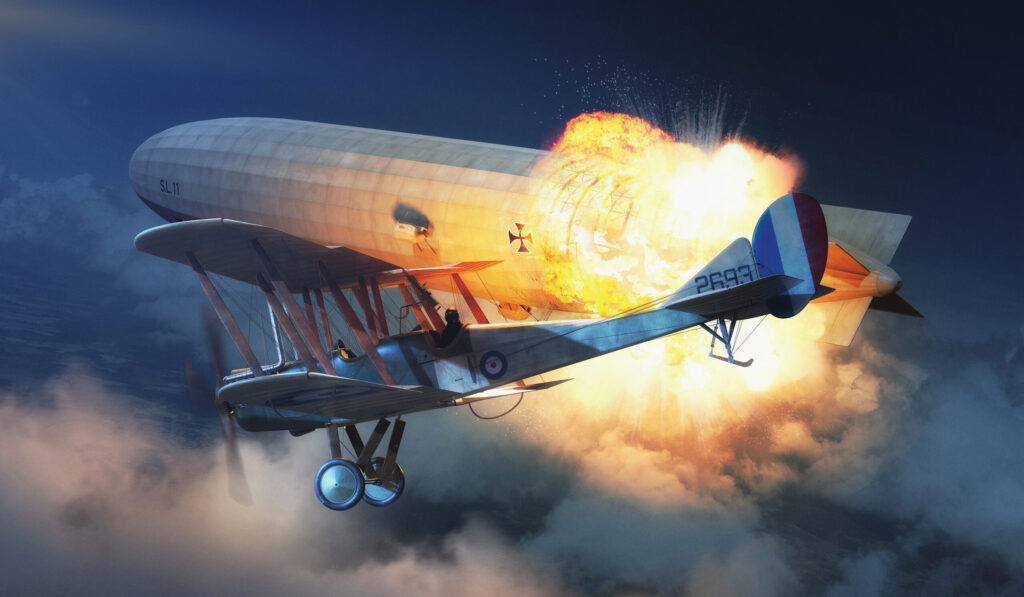
One development of the B.E.2 that has come under a particular degree of unfair criticism was the B.E.12, which many aviation historians have derided as the RAF’s failed attempt to create a single-seat fighter. Actually the B.E.12 first flew in July 1915, long before effective forward-firing armament was available in Britain, and the RAF conceived it as a single-seat bomber and photo-reconnaissance platform. It received a forward-firing machine gun much later, after the perfection of synchronizing mechanisms. Although lacking the maneuverability needed by a front-line fighter, the B.E.12’s excellent stability and forward-firing armament made it a useful home-defense night fighter. One contributed to the destruction of Zeppelin L48 on June 17, 1917.
Although the exact figures are not precisely known, it is estimated that the total production number of all B.E.2 variants was about 3,500, the vast majority being the B.E.2c version. The B.E.2c equipped no less than 72 RFC squadrons and four Navy squadrons. Belgium’s small air service used B.E.2cs and B.E.2ds powered by Hispano-Suiza engines after sensibly modifying theirs to put the pilot up front with a synchronized Vickers machine gun and the observer aft, manning a .303-inch Lewis machine gun on a ring mounting. In August 1918 the U.S. Army Air Service purchased B.E.2es for training purposes. B.E.s served not only over the Western Front but also the Mediterranean, the Middle East, South Africa and Australia.
The B.E.2c was essentially a good airplane that simply outlasted its time but performed as intended until the evolving air war made it obsolete. Its large production, a huge number for such an early airplane, belies the undeserved bad reputation of an airplane that successfully fulfilled a wide variety of military roles all over the world right to the end of World War I.

